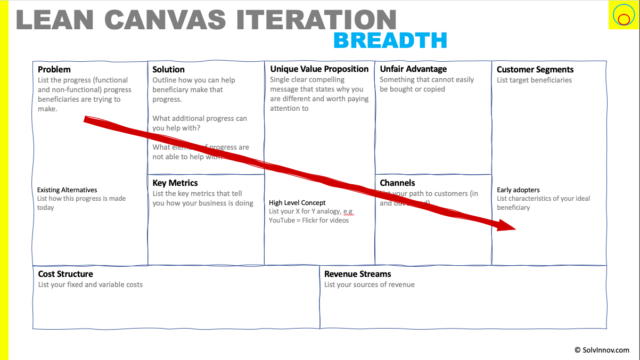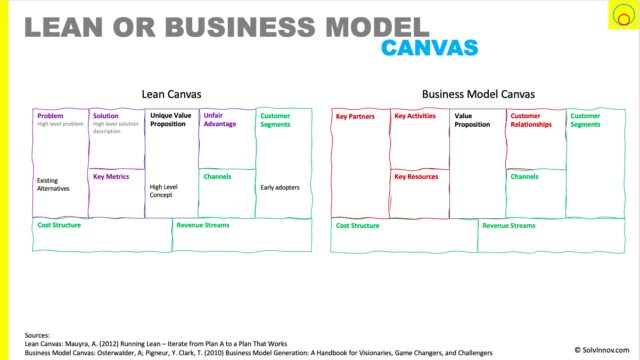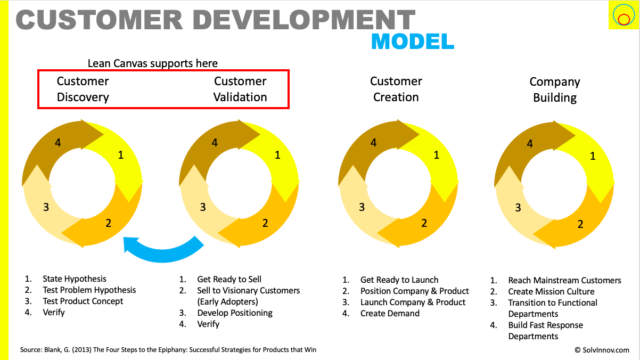The Big Picture…
Do you want to empower ideators to take their exciting ideas towards innovations? Helping them increase the quality, alignment, and completeness of those ideas in a language that the business understands? Whilst doing so in an non-intimidating way that is ripe for coaching and reviewing. As well as in away that supports collaboration?
Then we should use the Lean Canvas in an iterative way. It acts as guide rails to get from ideas to innovations.

We start with the simplest capture of an idea – the first view of the problem/solution pair and place it in the lean canvas. Then the ideator themselves, or as a result of coaching, reviews, or collaboration, repeatedly take steps to develop the idea in the canvas. Perhaps developing a particular segment more (a depth iteration). Or refining one segment based on thoughts from another segment (a breadth iteration).
Our ideator iterates as far as they feel comfortable. And can easily seek collaborators and peer or formal reviews to go further. Whilst the idea develops in a language and structure that is readily understandable to business sponsors.
We can use it in the systematic hunt for innovations, since we typically start with the problem/solution pair. Or we can embed it in the current toy of choice for innovation – call-to-actions.
Though, it doesn’t really matter where we start – the problem, the solution, somewhere else – the process fleshes out an investable idea (or that it is not investable, and why).
Implications
Using the Lean Canvas in an iterative manner minimises generating ideas that we don’t / can’t do anything with. We minimise performing innovation theatre, which lies at the heart of the innovation problem.
I’ve found it empowers ideators in a non intimidating way. There’s excitement about using such a tool, and a sense of achievement in taking their own idea and developing it further. And, given the consistent structure, it makes it easy for ideator to ask for coaching, or to seek collaborators. All whilst evolving an idea in the language of idea investors.
However, it is not the complete answer. It does not, for example, help us with the challenge of understanding (or altering) execution complexity. For that we need a different tool. Or if an enterprise can execute the innovation.
The idea
Two challenges I often find ideators have are how to a) turn an idea into an innovation (and sometimes to see that an idea itself is not an innovation) and b) explain their innovation to a potential sponsor in a way that is readily understandable – or investable, you could say.
Ideas generated, for example through call toactions, often:
- lack quality (in the description, completeness, usefulness, etc)
- are misaligned with enterprise
- not readily understandable to sponsors/wider business/others
- are too complex to implement in the enterprise (or we don’t understand the execution complexity).
That is to say, we can generate many ideas in an ideation process that we don’t / can’t do anything with – we are performing innovation theatre. Lots of action with limited tangible output, but everyone feels great (except, perhaps, the 94% of executives unhappy with innovation performance).
From experience, I find using the Lean Canvas Model in an iterative way is intuitive and empowering to address these challenges. I started doing this some 6 years ago to good effect and happy users. And you see the basic idea is in Figure 1.

We start with how a typical ideator views their idea – a simple problem-solution pair. Then they make iterations to fill out the complete lean canvas. This is not some radical idea, rather a simple leveraging of a tool that becomes very useful. Some iterations refine an existing section of the canvas, making it more comprehensive. I’ll call those depth iterations. Other iterations start by reviewing one section that triggers us to update other sections. And those I’ll breadth iterations. The process then repeats.
Although, it doesn’t really matter where we start – the problem, the solution, somewhere else – the iteration process fleshes out an investable idea (or discovers it is not investable, and why),
How does using lean canvas iteratively solve the challenges?
The canvas’ structure provides guide rails helping the ideator travel from initial thoughts to a fleshed out idea. As well as a common view and language to support collaboration and reviewing. And reduces the language gap between ideator and investor.
Whereas the iteration process are the steps ideators use to ride the guide rails. That we suggest there are iterations reduces performance anxiety of ideators – we start off with the view that not everything is known initially. Whilst the non prescriptive manner of iterations allows creativity to remain unconstrained. And the outcome should overcome the identified quality issues. It will be more complete and useful. Or, the ideator will discover that their initial idea will not flesh out to be an idea that is investable.
When ideators see the guide rails and understand the simple concept of iteration they become empowered to think more about their idea. Often fleshing it out further than they think they could. And they find seeking collaborators and/or reviews a much simple task.
OK, let’s look a little deeper at the Lean Canvas and the two iteration moves. After that, I’ll discuss why I use lean canvas and not, say, the Business Canvas Model. As well as why iteration is an important approach.
What is the Lean Canvas?
Ash Maurya created the Lean Canvas as an adaption of Alex
We can see it as a business plan on a page. Answering what:
- problem are we addressing, and how are we proposing to address that?
- is the unique value proposition and why do we have an unfair advantage over others?
- customer segments are there as well as who are the early adopters (remember those from innovation adoption?)? And how are we going to communicate with them (channels), remembering messages and media might need to change after 16% adoption?
- metrics are we going to use to measure our (the enterprise) success?
- are the cost structure and revenue streams?
I like to look at this through a service-first lens – aligning with an evolved view of value. And so our problem to solve becomes the progress beneficiaries are trying to make (progress sought). Our solution is how we are offering to help the beneficiary (progress offered). And with customer segments we should probably go beyond the classic segmentation by, say age, demographics etc, and leverage Christensen’s thinking about jobs to be done.
And it is with that lens that I describe the lean canvas in this article.
Iterating over the Lean Canvas
Iterating over the lean canvas is a simple process of making breadth and depth iterations. This truly is no magical deep insight. Rather a very simple way to help ideators visualise what iterations might look like. Some will flesh out a particular box (depth)and others will trigger development of another box (breadth). Which in turn may trigger insights on how to make the next depth and/or breadth iteration. And so on.
It is helpful to provide a starting point for iterating from. And in common with the original 2012 and 2016 approaches, I suggest the problem/solution pair is the natural entry to iteration.
Starting with the Problem / Solution Pair
Most ideators will naturally start with a simple statement of a problem and their solution. They might come from a moment of inspiration, or a thought process, or perhaps an innovation contest (for example a reply to a call to action). So, we capture both of these as shown in Figure 4.
There are several entry points into this view. The problem could be pre-defined by the enterprise. In which case we would expect it to be fairly well defined. Or the ideator might have solution in mind – a lash on inspiration perhaps – for which they have a vague problem description. Alternatively, the ideator might have a good view of the problem they see and the solution. Or a problem they see and they want to get creative. And so on.
I have found it less common to have an entry point to the Lean Canvas from a different segment. But it is not unheard of. Say you believe you have an unfair advantage; that could be the entry point to iterating.
The important part is we should not constrain the ideator. We suggest some entry points and the canvas itself as the guide rails. And we suggest there are two types of iteration that can be made from the entry point. First, we can make the next iteration broader, i.e. to add more information about the idea to other segments of the canvas. Or we can make the next iteration deeper, i.e. we increase information about one or more of the existing fields.
Making a Breadth iteration
An previous update in one segment of the canvas can trigger us to make an update in other segments. This makes out iteration broader. And so I call it a breadth iteration.
For example, once we initially write the problem down, it might trigger thoughts on who the early adopters might be; as in Figure 5. Or we might get that trigger once we have clarified the problem in a later step. Similarly, updating the unfair advantage segment might trigger an update to the unique value proposition. Or updating early adopters could trigger further insights to the problem description.
And we are not limited to a one-one relation. Several segments might be updated at once due to the last iteration.
We are adding additional information about the idea. And that additional information can easily come from the original idea creator having thought about the idea more. Or it can come from a collaborator, or the result of some informal or formal review process.
Making a Depth Iteration
Similarly, we can refine an existing segment of the canvas. This I’ll call a depth iteration.
We could, for example, refine the clarity of the problem without that refinement coming from updating any other segment. And the source of that refinement could come spontaneously from the ideator. Or it might come from a collaborator, or and formal/informal review process.
And that’s it, really. A simple, but empowering idea built on the solid basis of the Lean Canvas. But why use Lean Canvas rather than the Business Model canvas? Well, glad you asked…
Why not use the original Business Model Canvas?
I could have used Osterwalder’s original Business Model Canvas. But I feel that looks more at the delivery capability of the business model rather than the idea itself. Those aspects are important, but less so for the context I am after.
I’ve put both canvases next to each other here in Figure 7. And you’ll notice they have the same shape, though several of the segments are different.
For example, the lean canvas removes the key partners, key activities, and customer relations aspects. And replaces then with problem, solution and unique value proposition (which would have been folded into the value proposition segment of the business model canvas).
If you’re interested in why and how the Lean Canvas developed from the Business Canvas, as well as understanding those segment differences, then I recommend reading this article.
And, of course, if you do a google search, you’ll find different types of canvas, created after Business Canvas became popular. There are service model canvas, for example. I don’t use these as my view is I want to tease out the idea – and that is service independent. (Or deeper put, I see the world as service based, and how we help a beneficiary make progress is by offering some combination of people, systems and physical resources for them to integrate with – which leads us to a service-service continuum, where goods are a mechanism for transporting service for use in future self-service).
There’s also some good research on why iterating (in general) is a good idea.
Why Iterate?
It is unlikely that you have a fleshed-out idea from the start. And so iterating is something we all do naturally. Using the Lean Canvas gives us some rails to follow.
Iteration is at the heart of the lean-approach. And Blank includes the following insight in his book “The Four Steps to Epiphany – Successful Strategies For Product That Win“:
only in business school case studies does progress with customers happen in a nice linear fashion. The nature of finding a market and customers guarantees that you will get it wrong several times. Therefore, unlike the product development model, the Customer Development model assumes that it will take several iterations of each of the four steps until you get it right.
Blank (2013)
This is equally true for ideas and innovation. We can look at Blank’s Customer Development Model (Figure 8) and see this.
Most of what we have looked at in the above is covering the first cycle: customer discovery. Where we have looked at our problem and iteratively tested that problem hypothesis and our product concept (solution) against itself. as well as identifying our early adopters used in the customer validation cycle. To fully harness the Customer Development Model we would look at testing our problem hypothesis and product concept with real customers in our target customer and early adopter segments.
There are two common ways to fill in the lean canvas. The first was described in 2012’s “Running Lean“. And the second in 2016’s “Scaling Lean – Mastering the Key Metrics for Startup Growth“. I look at these in my article on the Lean Canvas.
My experience is that we should be a little looser and let the ideator or team bounce of each other (or themselves) organically improving the idea towards an innovation, within the framework of the canvas. This allows an ideator to go as far as they feel comfortable and then seek additional help. And for synergistic review of the canvas by sponsors, internal to team or elsewhere.
Wrapping up
Using the Lean Canvas in an iterative manner is a great tool to empower ideators. It helps flesh out simple problem/solution pair into an investable idea (or not, and why not). The entry point is typically the initial view of the problem/solution pair. And then a number of breadth and depth iterations are made.
Ideators can pull the tool off the shelf whenever inspiration strikes them. Or it can be used as part of systematic hunting for innovation. And, the concept can be embedded within call-to-action approaches; and more. We are trying to minimise innovation theatre, and therefore reduce the innovation problem.
At the same time we don’t want to stifle creativity with overly complicated process or intimidation. The lean canvas is useful in reducing ideator anxiety, opening up collaboration opportunities and supporting a variety of reviewing activities.
Last, but not least, the canvas itself is couched in the language of business investors. Using it helps us minimise the language gap often found between ideators and investors.
It is part of the solution to the innovation problem. However, not the complete answer. It does not, for example, help us with the challenge of understanding (or altering) execution complexity. For that we need a different tool. Nor does it tell us if an enterprise can execute the innovation.






